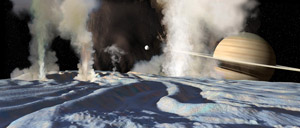 The Gallery at Penn College, on the third floor of the Madigan Library at Pennsylvania College of Technology, will host "Out of This World: Landscapes of Our Solar System" from March 13 to April 19, offering opportunities for area schools to attend interactive lectures related to the show.
The Gallery at Penn College, on the third floor of the Madigan Library at Pennsylvania College of Technology, will host "Out of This World: Landscapes of Our Solar System" from March 13 to April 19, offering opportunities for area schools to attend interactive lectures related to the show.
The visually dazzling traveling exhibit pairs detailed photos taken by interplanetary robotic explorers with the work of 12 of the best-known space artists of the 20th and 21st centuries. Capitalizing on new color-imaging and printing technology to reveal the art of space science in all its beauty and wonder, the show chronicles the relationship between space science and space art and brings together the real and the imagined landscapes of our solar system.
Grounded firmly in scientific research using the most current data available, but inspired by creativity and imagination, the artwork informs, inspires and sparks our sense of adventure. The artists' work has been used by NASA and has been featured in numerous books on astronomical art, in scientific textbooks on our solar system, and on the covers of major scientific periodicals.
The exhibit also includes a dazzling, dizzying computer simulation of a fly-through of Mariner Valley on Mars, produced by the Jet Propulsion Laboratory, and a compelling documentary film on the history of space exploration narrated by Harrison Ford.
The exhibit was developed by the Hearst Art Gallery in collaboration with the Physics and Astronomy departments of Saint Mary's College of California.
Participating artists are Joe Bergeron, Michael Carroll, Kevin Davies, Don Dixon, Mark A. Garlick, David Hardy, William K. Hartmann, Frank Hettick, John Kaufmann, Ron Miller, Walter B. Myers and Kees Veenenbos.
The gallery will host an opening reception March 15 from 4:30 to 6:30 p.m.
The gallery is offering opportunities for area schools to tour the exhibit and attend an interactive presentation by Penn College physics professor David S. Richards. Geared to students in fifth to eighth grade, Richards' talk will demonstrate the size of the planets relative to the earth and moon, explain how scientists send spacecraft to other celestial bodies, and examine the interesting surface features of these peculiar worlds. Students will learn why Venus is the hottest planet in our solar system and how we can map out its surface, even though the entire planet is covered with clouds.
The gallery is open Sunday, 1 to 4 p.m.; Tuesday and Thursday, 2 to 7 p.m.; and Wednesday and Friday, 11 a.m. to 5 p.m. (closed Saturday and Monday). The gallery will be closed April 6-8.
For more about the exhibit and The Gallery at Penn College, visit online , email or call 570-320-2445.
For more about Penn College, visit on the Web , email or call toll-free 800-367-9222.
